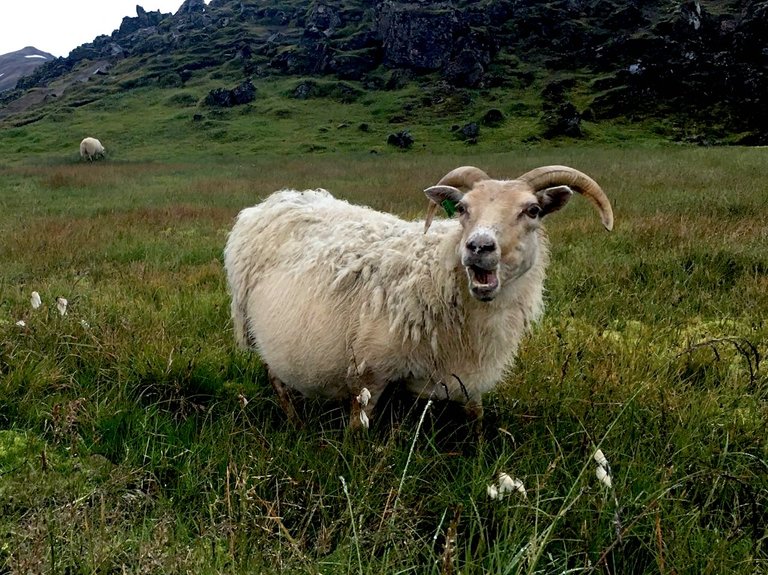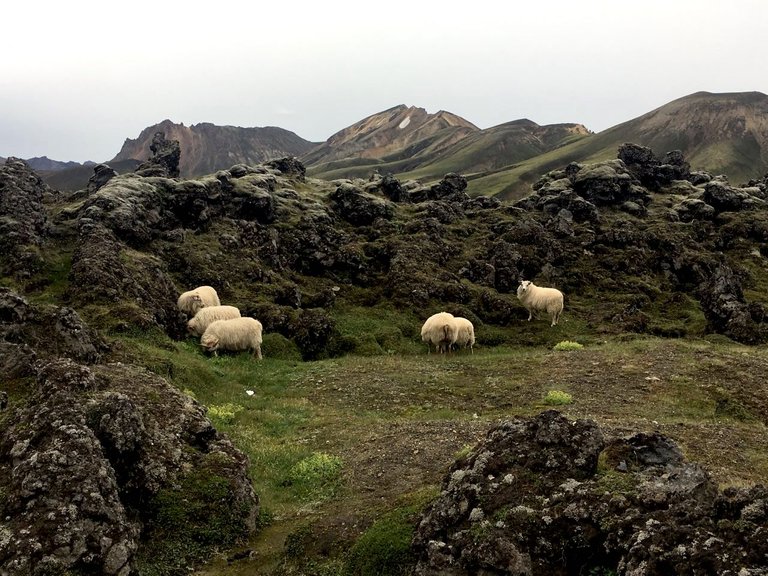
 |  |
|---|
Among the many peculiarities of the Icelandic land it is impossible not to notice the particular sheep that roam everywhere, in total freedom, in the boundless meadows of the island, especially for those who love animals. These sheep live only here and are different from those normally observable in Europe, and for this reason they show some traits that turn out to be perfect adaptations to the place in which they live.
The Icelandic sheep, Ovis aries, or íslenska sauðkindin, is a species of sheep that was imported from Norway by the Vikings around the tenth century. In more than a thousand years spent in total isolation, it has not had the chance to breed with sheep of other species, and for this reason it represents an ancient and pure stock. However, he has developed numerous absolutely characteristic traits, which represent a perfect evolutionary adaptation to the harsh climate in which he lives; the two most characteristic elements are certainly the thick wool that forms a double layer, suitable to fight the great cold and the strong wind, and the appendages (tail, ears, but also legs) extremely shortened, to reduce the surfaces exposed to frost.
It should not be surprising that, in the absence of breeding with other species, genes for these characteristics, perfectly adapted to the environment, have spread rapidly (from an evolutionary point of view 1000 years represent an extremely short time). The specimens that first manifested these traits, in fact, have certainly obtained a considerable competitive advantage over the others, gaining the possibility of spreading their genetics heritage more effectively.
Another particular adaptation is that related to the reproductive system. Every season, mothers give birth to two twins, and this is probably the best way to guarantee offspring in adequate numbers considering the relationship between farm costs and survival possibilities.
Tra le tante peculiarità della terra islandese è impossibile, soprattutto per chi ama gli animali, non notare le particolari pecore che si aggirano ovunque, in totale libertà, negli sconfinati prati dell’isola. Si tratta di ovini presenti unicamente qui, diversi da quelli normalmente osservabili in Europa, e proprio per questo motivo dotati di alcuni tratti che risultano essere dei perfetti adattamenti al luogo in cui vivono.
La pecora islandese, Ovis aries, o íslenska sauðkindin, è una specie di pecora che venne importata della Norvegia dai vichinghi attorno al X secolo. Nei più di mille anni passati in totale isolamento, non ha avuto modo di incrociarsi con esemplari di altre specie, e per questo rappresenta un ceppo antico e puro. Ha però sviluppato numerosi tratti assolutamente caratteristici, che rappresentano un perfetto adattamento evolutivo rispetto al duro clima in cui vive; i due elementi più caratteristici sono sicuramente la folta lana che forma un doppio strato, adatta a combattere il grande freddo e il forte vento, e le appendici (coda, orecchie, ma anche zampe) estremamente accorciate, per ridurre le superficie esposte al gelo.
Non dovrebbe sorprendere che, in assenza di incroci con altre specie, caratteristiche del genere, perfettamente adattate all’ambiente, si siano diffuse rapidamente (da un punto di vista evolutivo 1000 anni rappresentano un tempo estremamente ridotto). Gli esemplari che per primi hanno manifestato questi tratti, infatti, hanno sicuramente ottenuto un vantaggio competitivo notevole rispetto agli altri, guadagnando la possibilità di diffondere con maggior efficacia il proprio patrimonio genetico.
Un altro adattamento particolare è quello relativo al sistema riproduttivo. Ogni stagione le madri partoriscono due gemelli, e questo rappresenta probabilmente il miglior modo per garantirsi una prole in numero adeguato considerando il rapporto tra costi di allevamento e possibilità di sopravvivenza.

Leaving from towns, it is possible to observe the Icelandic sheep practically everywhere, from the plains to the mountains, with the only exception of the cold glaciers. The herds, in fact, are left completely free during the "warm" period, so that the breeders also travel hundreds of kilometers to gather all the animals, when they recover them for the winter.
The recovery of herds is so complicated that it gives rise to a real event, called Réttir, during which the breeders gather the whole family, and all the relatives help in the process.
Everything is made even more complicated by the social habits of the sheep: although we speak of herds, in fact, these animals are used to roam in groups of three, composed by the mother and the two twins, even at great distances from each other.
All these sheep, however, also retain the ability to live in a pack; in fact, some of these show particular colors and are identified as "head of the pack". Although from a biological point of view it is the same species, breeders tend to consider them as different strains, because the heads of the pack are the only ones able to show soecific behaviors useful to drive and defend the herd. Unfortunately they are less suitable for commercial purposes and, therefore, the breeders tend not to possess an adequate number; this has led, in recent years, to believe the whole species "endangered".
Uscendo dai centri abitati, è possibile osservare le pecore islandesi praticamente in ogni luogo, dalle pianure alle montagne, con l’unica eccezione dei freddi ghiacciai. Le mandrie, infatti, vengono lasciate completamente libere durante il periodo “caldo”, tanto che gli allevatori, quando le recuperano per l’inverno, percorrono anche centinaia di chilometri per radunare tutti i capi.
Il recupero delle mandrie è talmente complicato che dà luogo ad un vero e proprio evento, chiamato Réttir, durante il quale gli allevatori riuniscono tutta la famiglia, e tutti i parenti aiutano nel processo.
Il tutto è reso ancora più complicato dalle abitudini sociali delle pecore: nonostante si parli di mandrie o branchi, infatti, questi animali sono soliti girovagare a gruppi di tre, composti dalla madre e dai due gemelli, anche a grandi distanze gli uni dagli altri.
Tutti gli esemplari, comunque, conservano anche la capacità di vivere in branco; alcuni di questi, infatti, manifestano colorazioni particolari e vengono identificati come “capibranco”. Nonostante da un punto di vista biologico si tratti della stessa specie, gli allevatori tendono a considerarli come ceppi diversi, poiché i capibranco sono gli unici in grado di mettere in atto comportamenti particolari di guida e difesa del branco. Purtroppo si tratta di individui meno adatti a fini commerciali e, per tanto, gli allevatori tendono a non possederne in numero adeguato; questo ha portato, negli scorsi anni, a ritenere l’intera specie “endangered”.

Currently these animals are reared mainly for the production of meat and wool, but breeders also try to exploit secondary products such as milk and skin. Milk, in particular, has recently found its vocation in the production of cheeses and typical dairy products. This is considered of fundamental importance by the breeders themselves, as extending as much as possible the economy linked to the Icelandic sheep is probably the only way to save it from extinction. Although today it is no longer considered in danger, in fact, it is undeniable that the farmers' attention is progressively shifting towards more productive species.
A great applause in this sense must be made towards the Icelandic administration, which applies strict rules that completely prohibit the importation of livestock other than the native one.
The hope, then, is that at least in this place the egoism and the human craving for gain will not lead to the extinction of a species that does not have and cannot have another home.
Attualmente questi animali vengono allevati prevalentemente per la produzione di carne e di lana, ma si cerca di sfruttare anche i prodotti secondari come il latte e la pelle. Il latte, in particolare, ha recentemente trovato la propria vocazione nella produzione di formaggi e prodotti caseari tipici. Questo è ritenuto di fondamentale importanza dagli allevatori stessi, in quanto estendere il più possibile l’economia legata alla pecora islandese rappresenta probabilmente l’unico modo per salvarla dall’estinzione. Nonostante ad oggi non sia più considerata in pericolo, infatti, è innegabile che l’attenzione degli allevatori si stia progressivamente spostando verso specie più produttive.
Un grande plauso in questo senso deve essere fatto nei confronti dell’amministrazione islandese, che applica rigide norme che vietano completamente l’importazione di altro bestiame che non sia quello autoctono.
La speranza, allora, è che almeno in questo luogo ancora l’egoismo e la smania di guadagno umana non portino all’estinzione di una specie che non ha e non può avere un’altra casa.
Sources

Immagine CC0 Creative Commons, si ringrazia @mrazura per il logo ITASTEM.
CLICK HERE AND VOTE FOR DAVINCI.WITNESS
World of Photography
>Visit the website<
You have earned 6.50 XP for sharing your photo!
Daily photos: 1/2
Daily comments: 0/5
Multiplier: 1.30
Block time: 2018-08-20T13:57:48
Total XP: 26.00/100.00
Total Photos: 4
Total comments: 0
Total contest wins: 0
Follow:
Join the Discord channel: click!
Play and win SBD:
Daily Steem Statistics:
Learn how to program Steem-Python applications:
Developed and sponsored by: @photocontests@fairlotto@dailysteemreport@steempytutorials @juliank
Thank you for your contribution to the "pc-animal" tag
Cheers,
Check out this post for information on all the Photocircle tags
Learn about this photo curation project by clicking >here
To stop receiving comments then reply
!STOP!@photocircle TeamThis post has been voted on by the steemstem curation team and voting trail.
There is more to SteemSTEM than just writing posts, check here for some more tips on being a community member. You can also join our discord here to get to know the rest of the community!
Hi @lycos!
Your post was upvoted by utopian.io in cooperation with steemstem - supporting knowledge, innovation and technological advancement on the Steem Blockchain.
Contribute to Open Source with utopian.io
Learn how to contribute on our website and join the new open source economy.
Want to chat? Join the Utopian Community on Discord https://discord.gg/h52nFrV
The picture at the top of the page caught my attention, and the rest did not disappoint. I love the fact that the people of Iceland are protecting this part of their heritage. The sheep are beautiful.
The coolest thing is that Icelanders try to protect the whole territory in the same way. But unfortunately many tourists do not help...
Have to admit I'm fond of Iceland. Love the Sagas. Love the way they threw bankers out when everybody else put up with the malfeasance. Love Halldor Laxness--think I read every one of his books. I guess it's irrational to love a place, but I am really fond of Iceland.
Not so irrational. I think it's a totally different country from those we're normally used to... And I can tell you without a doubt that I have fallen in love with it too.
:)